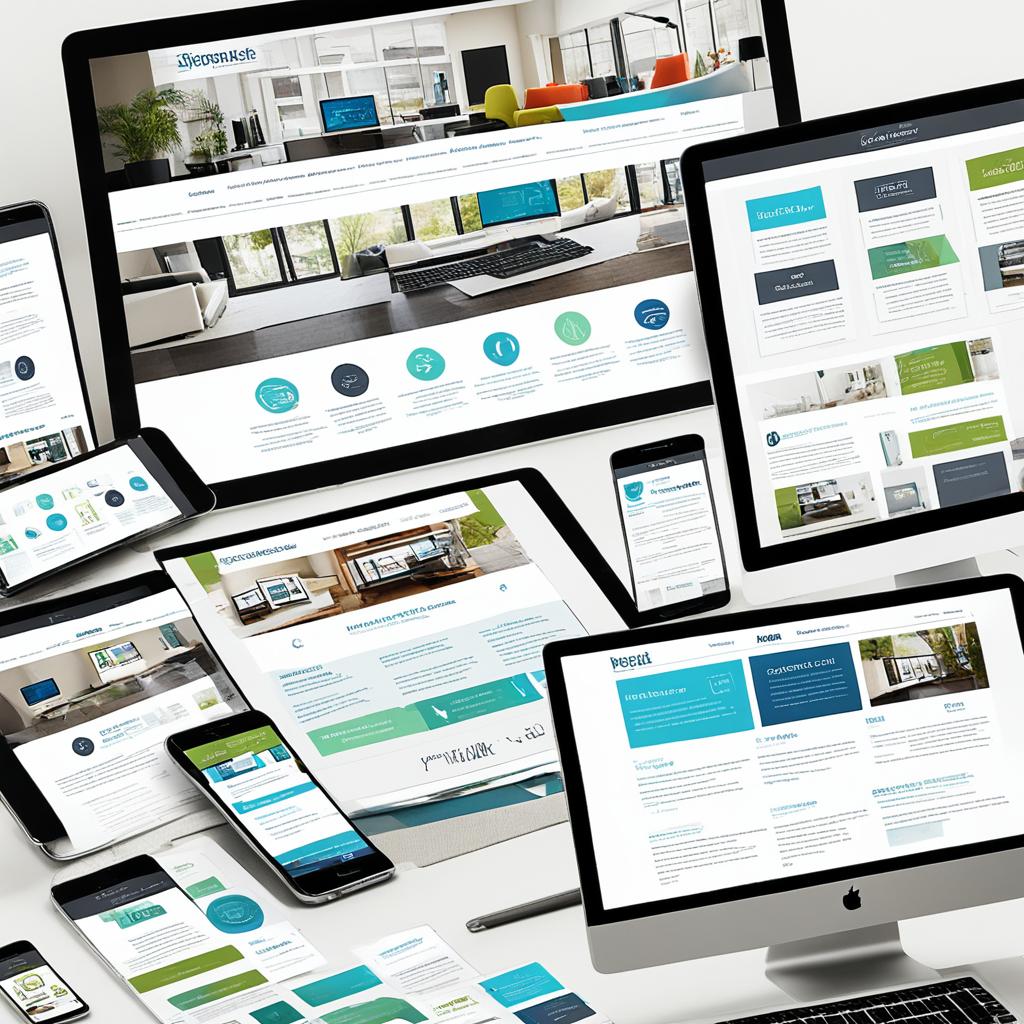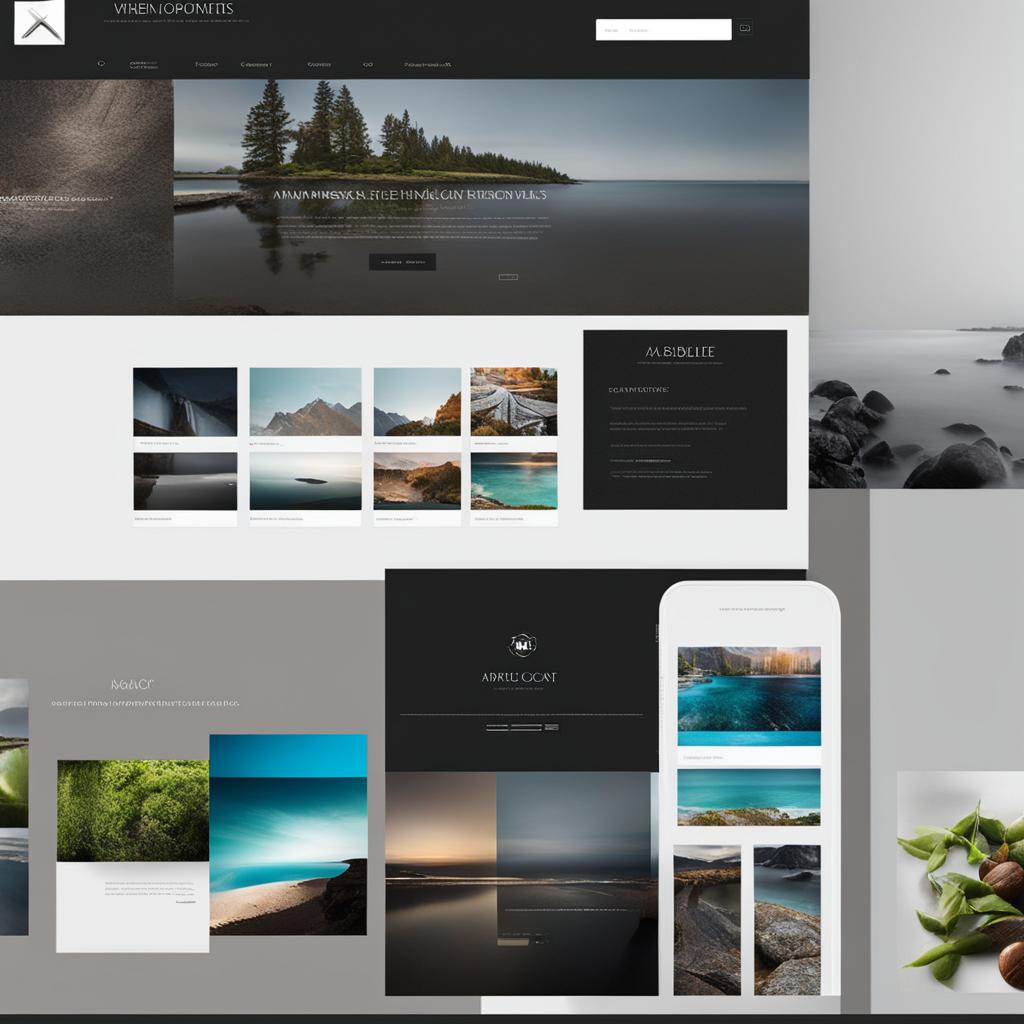As a freelance web designer, having a strong portfolio is essential for showcasing your skills, attracting clients, and establishing your credibility in the industry. Your portfolio serves as a visual representation of your expertise, creativity, and ability to deliver exceptional web design work.
In this article, I will guide you step-by-step on how to create a standout portfolio that will impress potential clients and set you apart from the competition. Whether you’re just starting out or looking to revamp your existing portfolio, these tips and strategies will help you craft a compelling online showcase of your web design work.
Key Takeaways:
- Having a portfolio is crucial for freelance web designers to showcase their skills and expertise.
- A portfolio serves as a visual representation of a web designer’s expertise and can attract potential clients.
- Choosing the right tools and organizing your portfolio are essential for creating a user-friendly website.
- Updating your portfolio regularly and leveraging SEO strategies can improve its visibility and attract more organic traffic.
- Your portfolio is an opportunity to showcase your personal brand and make a lasting impression on potential clients.
The Importance of a Portfolio for Freelance Web Designers
As a freelance web designer, having a portfolio is crucial for showcasing your skills, attracting clients, and establishing your professional credibility. A portfolio serves as a powerful tool to display your best work, demonstrate your expertise, and build trust with potential clients. It allows you to create a professional website design showcase that highlights your unique talents and capabilities. Whether you’re just starting your career or have years of experience, a portfolio website design gallery is essential to differentiate yourself in the competitive web design industry.
By curating a portfolio, you can showcase your creativity, design style, and ability to solve complex problems. It provides a visual representation of your capabilities and helps clients envision what you can create for them. A portfolio acts as a virtual storefront, allowing potential clients to browse through your past projects and get a sense of your skills and expertise.
With a well-organized and visually appealing portfolio, you can create a lasting impression on potential clients, giving them confidence in your abilities. A professional website design showcase can act as a persuasive tool, highlighting your expertise in various areas such as responsive design, user experience, and graphic design. It allows clients to see real examples of your work and evaluate your suitability for their specific project requirements.
Building Trust and Establishing Your Brand
A portfolio not only demonstrates your web design skills but also helps you build trust and establish your personal brand. By showcasing your previous projects, testimonials, and client feedback, you can show potential clients that you have a track record of delivering exceptional results. This builds credibility and instills confidence in your abilities as a freelance web designer.
Investing time and effort into building a professional portfolio signals to clients that you are serious about your work and committed to providing high-quality web design services. It differentiates you from other designers who may not have a portfolio, giving you a competitive edge.
Furthermore, a well-curated portfolio allows you to showcase your unique design style and approach. It defines your brand identity and sets you apart from other web designers. Clients often look for web designers with a specific aesthetic or design philosophy that aligns with their vision. Your portfolio acts as a creative portfolio design inspiration to potential clients, showing them your ability to bring their ideas to life and create stunning web design portfolios.
The Visual Impact of a Professional Portfolio
A professional website design showcase not only highlights your skills and capabilities but also serves as a visual representation of your talent and creativity. Utilizing captivating visuals and interactive elements in your portfolio can engage potential clients and leave a lasting impression.
By incorporating high-quality images and design samples, you can showcase the full potential of your web design expertise. Whether it’s responsive websites, e-commerce platforms, or dynamic web applications, a visually appealing portfolio can demonstrate your versatility and ability to create stunning web design portfolios.
Showcasing Your Expertise in a Crowded Market
In an increasingly competitive market, a portfolio is essential to stand out as a freelance web designer. It allows you to highlight your strengths, experience, and specialized skills, making it easier for potential clients to find and choose you. It also creates opportunities for you to attract targeted clients who appreciate your unique expertise.
With a curated portfolio, you can showcase your previous work with clients in specific industries. This allows you to demonstrate your understanding of their unique needs and challenges, making you an attractive choice for similar projects. Clients are often looking for web designers with experience in their industry, and your portfolio can position you as an expert in their field.
Remember, in the competitive world of web design, a professional portfolio can be the key to unlocking new opportunities, attracting clients, and establishing your reputation. A visually compelling website design showcase can make a world of difference in convincing potential clients that you are the perfect fit for their projects.
| Benefits of Having a Portfolio as a Freelance Web Designer | How a Portfolio Helps Build Trust and Establish Your Brand | The Visual Impact of a Professional Portfolio | Showcasing Your Expertise in a Crowded Market |
|---|---|---|---|
| – Showcasing your skills, abilities, and expertise | – Building credibility and instilling confidence in your abilities | – Using captivating visuals to leave a lasting impression | – Targeting specific industries and attracting relevant clients |
| – Attracting clients by demonstrating your design style and approach | – Creating a lasting impression through past projects and testimonials | – Demonstrating versatility and expertise through design samples | – Standing out in a competitive market by highlighting your strengths |
| – Differentiating yourself from other web designers | – Establishing your personal brand identity | – Engaging potential clients through interactive elements | – Positioning yourself as an industry expert |
Benefits of Having a Portfolio as a Freelance Web Developer
As a freelance web developer, having a portfolio offers several advantages. It allows you to make money while you’re learning and gain practical experience in real-world projects. Building your portfolio enables you to showcase your skills, demonstrate your expertise, and attract potential clients. Here are some key benefits of having a portfolio as a freelance web developer:
- Try out different types of projects: Having a portfolio gives you the opportunity to work on a variety of projects and explore different areas of web development. This allows you to discover your strengths and interests, helping you find your niche in the industry.
- Prepare for a full-time job: Building a portfolio while freelancing gives you the chance to develop the skills and experiences needed for a full-time job in web development. It demonstrates to future employers that you have practical experience and the ability to deliver high-quality work.
- Build valuable portfolio projects: By taking on freelance projects, you can create valuable portfolio pieces that showcase your abilities and expertise. These projects serve as tangible examples of your work and can help you attract more clients in the future.
- Gain confidence in your web development skills: Working on real projects and building a portfolio allows you to refine your web development skills and gain confidence in your abilities. As you complete projects successfully and receive positive feedback, your confidence will grow, enabling you to take on more challenging projects.
- Be your own boss and enjoy more freedom: Freelancing as a web developer offers the freedom to work on your own terms. You have the flexibility to choose the projects you want to work on, set your own rates, and manage your own schedule. This autonomy allows you to pursue your passions and create a work-life balance that suits you.
“Building a portfolio as a freelance web developer is a game-changer. It not only helps you gain experience and make money while learning but also gives you the freedom to showcase your skills and attract clients who appreciate your expertise.”
Having a portfolio as a freelance web developer is essential for your professional growth and success. It provides a platform to demonstrate your abilities, build your reputation, and establish yourself as an expert in the field. Start building your portfolio today and unlock the potential to take your freelance web development career to new heights.
When to Create a Portfolio as a Freelance Web Developer
As a freelance web developer, it is never too early to create a portfolio. Even if you’re just starting out and feel like you’re not quite ready, having an online presence can help you start looking for work and gain valuable experience. Your portfolio doesn’t need to be perfect; it simply needs to showcase your best work and demonstrate your abilities. With the right examples and expert portfolio web design services, you can create a professional and impactful portfolio.
Creating a portfolio early on allows you to:
- Start looking for work: Having a portfolio online means you can start actively searching for freelance web development opportunities. By showcasing your skills and projects, you make it easier for potential clients to find and hire you.
- Gain experience: Building your portfolio helps you gain hands-on experience and refine your web development skills. It allows you to experiment with different projects and technologies, which can expand your knowledge and make you a more versatile web developer.
- Showcase your abilities: Your portfolio serves as a visual representation of your capabilities. By including your best work, you can demonstrate your expertise in web development and impress potential clients with your skills and creativity.
Don’t worry if you feel like you don’t have enough projects to showcase or if you’re still working on improving your skills. Your portfolio is a reflection of your growth as a web developer, and it will evolve over time. Start with what you have, and as you complete more projects and gain more experience, you can continue to update and enhance your portfolio.
Expert Portfolio Web Design Services
If you’re looking to create a professional portfolio but don’t have the web design skills or time to do it yourself, expert portfolio web design services can be a valuable resource. These services offer specialized knowledge and experience in building portfolios that effectively showcase your work and attract potential clients.
With expert portfolio web design services, you can:
- Benefit from professional design: Professional designers know how to create visually appealing and user-friendly portfolio websites. They can enhance the overall look and feel of your portfolio, making it stand out among others.
- Optimize your portfolio for search engines: Expert designers understand the importance of SEO and can optimize your portfolio website to improve its visibility in search engine results. This can help attract more organic traffic and increase your chances of being discovered by potential clients.
- Utilize industry best practices: Portfolio web design services stay updated with the latest trends and best practices in the industry. They can incorporate elements and features that are proven to engage visitors and effectively showcase your work.
When choosing expert portfolio web design services, make sure to research and consider their portfolio examples. Look for designs that align with your style and goals, and inquire about their process and timeline. Remember, your portfolio is an essential tool for attracting clients, so investing in professional help can be a worthwhile investment in your freelance web development career.
Choosing the Right Tools for Your Portfolio Website
When it comes to building your portfolio website, there are a few options to consider. You can choose to code it from scratch, or you can utilize a content management system (CMS) like WordPress. Both options have their advantages and it’s important to choose the one that best suits your needs and capabilities.
If you’re proficient in web development and want full control over every aspect of your website, coding from scratch might be the right choice for you. This approach allows you to customize every detail and tailor your portfolio to your exact specifications. However, it requires advanced coding skills and can be time-consuming.
If you’re not well-versed in coding or prefer a more user-friendly approach, using a CMS like WordPress can be a great solution. WordPress offers a wide range of themes and templates specifically designed for portfolio websites, making it easier to showcase your work effectively. It also provides a user-friendly interface, allowing you to easily manage and update your portfolio without extensive coding knowledge.
Aside from coding from scratch or using CMS platforms like WordPress, there are also other top portfolio websites available that can provide inspiration and serve as examples of creative portfolio design. These platforms offer pre-designed templates and layouts, allowing you to quickly create a visually appealing portfolio without the need for extensive coding.
When choosing the right tools for your portfolio website, it’s essential to consider your target audience, the type of projects you want to showcase, and the tools and programming languages you are familiar with. This will help you create a portfolio that aligns with your goals and effectively presents your work to potential clients.
Remember, the key is to create a visually captivating and user-friendly portfolio that highlights your skills, creativity, and expertise as a designer. By carefully selecting the right tools and platforms, you can create a portfolio website that makes a lasting impression on your visitors.
Creating a Compelling About Section
Your about section is an opportunity to introduce yourself to potential clients and showcase your unique value proposition. It should highlight your skills, experience, and what sets you apart from other web designers.
Hi, I’m [Your Name], a freelance web designer with [X] years of experience in creating stunning web design portfolios. I specialize in [specific design style or niche]. My passion for design and dedication to delivering visually captivating websites allows me to bring clients’ visions to life.
Highlighting Expertise
With a strong background in [relevant skills or expertise], I have collaborated with a diverse range of clients, from startups to established businesses, to create stunning web design portfolios that showcase their brand identity and achieve their business goals.
Industry Recognition
I am proud to have been recognized for my work, receiving [relevant certifications or awards]. These accomplishments are a testament to my commitment to excellence and my ability to deliver exceptional results for my clients.
Notable Projects and Clients
“Working with [notable client name] allowed me to create a high-impact website that exceeded their expectations and contributed to their online success. It was a privilege to collaborate with a brand that values innovation and aesthetics.”
Passion and Creativity
I am deeply passionate about web design and constantly seek inspiration from the latest trends and innovations. My creative approach allows me to develop unique and engaging websites that captivate users and leave a lasting impression.
Client Satisfaction
“I prioritize client satisfaction and strive to establish long-lasting relationships built on trust and open communication. Creating compelling web design portfolios that not only meet but exceed client expectations is my ultimate goal.”
Let’s Collaborate
If you’re looking for a web designer who can bring your vision to life and create a stunning web design portfolio for your brand, I would love to connect. Contact me today to discuss your project and explore the possibilities!
| Why Choose Me? | My Skills | Testimonials |
|---|---|---|
| ✓ Unique and captivating web designs | ✓ HTML, CSS, JavaScript | “[Client Name]: [Testimonial]” |
| ✓ Attention to detail and pixel-perfect implementation | ✓ UI/UX design | “[Client Name]: [Testimonial]” |
| ✓ Responsive and mobile-friendly layouts | ✓ Adobe Creative Suite | “[Client Name]: [Testimonial]” |
| ✓ Timely project delivery | ✓ Cross-browser compatibility | “[Client Name]: [Testimonial]” |
Highlighting Your Best Work
When it comes to building an impressive portfolio, showcasing your best work is crucial. You want to provide potential clients with a clear demonstration of your skills and expertise in web design. By selecting projects that align with your target audience and highlight your abilities, you can make a lasting impression on those who visit your portfolio website.
Consider including a variety of projects in your portfolio to showcase your versatility as a web designer. This can include websites, web applications, e-commerce sites, and more. By demonstrating your range of skills and abilities, you can attract a wider range of clients and position yourself as an expert in the field.
Here is an example of how you can organize and highlight your best work in your portfolio:
| Project | Description | Skills Demonstrated |
|---|---|---|
| Website Redesign for ABC Company | A complete revamp of the client’s outdated website to improve user experience and increase conversions. | UX design, responsive web design, conversion optimization |
| E-commerce Site for XYZ Brand | Designed and developed an intuitive and visually appealing e-commerce platform for a fashion brand. | E-commerce design, product listing optimization, payment integration |
| Web Application for 123 Organization | Created a custom web application to streamline the client’s internal processes and improve efficiency. | Backend development, database management, API integration |
By showcasing your best work and providing detailed descriptions of each project, you can effectively communicate your expertise and attract potential clients who are looking for the specific skills you possess. Remember to constantly update your portfolio as you complete new projects to ensure it remains fresh and relevant.
Organizing Your Portfolio
When it comes to showcasing your website design portfolio, organization is key. A well-structured portfolio ensures a seamless user experience and makes it easy for potential clients to navigate and find the information they are looking for.
One effective way to organize your portfolio is by categorizing your projects. Consider grouping them by industry, type, or client, so visitors can easily find relevant examples. This categorization helps potential clients quickly identify your expertise in their specific niche.
Additionally, creating case studies for each project can provide further insight into your design process and problem-solving abilities. These case studies should include details on the objectives, challenges, and solutions implemented for each project. This level of transparency showcases your expertise and allows potential clients to understand your approach.
Here’s an example of how you can organize your portfolio:
| Category | Project Name | Description |
|---|---|---|
| Industry | XYZ Corporation | A responsive website design for XYZ Corporation, showcasing their products and services. |
| Type | E-commerce | A visually stunning and user-friendly e-commerce platform for an online fashion retailer. |
| Client | Company A | A custom website design for Company A, highlighting their brand identity and core values. |
By organizing your portfolio in a clear and logical manner, you provide potential clients with an easier and more engaging experience. Plus, it allows them to quickly assess how your skills and expertise align with their specific needs. Remember to regularly update your portfolio and add new projects to keep it fresh and relevant.
Creating a User-Friendly Portfolio Website
When it comes to showcasing your web design portfolio, creating a user-friendly website is crucial. A visually appealing and easy-to-navigate portfolio can make a lasting impression on potential clients. Here are some essential tips to help you create a stunning web design portfolio:
1. Visual Appeal
A visually appealing portfolio website can captivate visitors and showcase your design skills. Use high-quality images of your work to create a visually stunning portfolio. Remember to optimize these images for web to ensure fast loading times. To give you an idea of what your portfolio could look like, here’s an example:
2. Easy Navigation
Ensure that your portfolio website is easy to navigate so that visitors can quickly find the information they are looking for. Use clear and concise menus and labels for different sections of your portfolio. Consider using a minimalist design to maintain simplicity and clarity throughout your portfolio website.
3. Mobile Optimization
In today’s mobile-driven world, it is essential to optimize your portfolio website for mobile devices. Ensure that your website is responsive and adapts seamlessly to different screen sizes. This will allow potential clients to access and explore your portfolio effortlessly, no matter what device they are using.
4. Compelling Descriptions
Accompany your design work with clear and concise descriptions that highlight the objectives, challenges, and solutions of each project. This will help potential clients better understand your design process and the value you bring to the table.
5. Call-to-Action
Include a prominent call-to-action on your portfolio website, encouraging visitors to contact you for inquiries or project collaborations. This can be in the form of a button or a contact form strategically placed throughout your portfolio website.
6. Testimonials and Reviews
Build trust and credibility by incorporating testimonials and reviews from satisfied clients. Displaying positive feedback can make potential clients more confident in your abilities and increase the chances of them reaching out to work with you.
By following these tips, you can create a user-friendly and visually stunning portfolio website that effectively showcases your web design work. Remember, your portfolio is a reflection of your skills and expertise, so make sure it leaves a lasting impression on potential clients.
Promoting Your Portfolio
Now that you’ve created your stunning web design portfolios the next step is to promote it and showcase your website design portfolio to attract potential clients. There are several effective strategies you can use to increase the visibility of your portfolio and reach your target audience.
Utilize Social Media Platforms
Social media platforms are powerful tools for promoting your portfolio. Share your website design portfolio regularly on platforms such as Facebook, Instagram, Twitter, and LinkedIn. Include captivating visuals and engaging captions to capture the attention of your audience. You can also join relevant design groups and communities to connect with like-minded professionals and potential clients.
Engage with Professional Networking Sites
Professional networking sites like Behance, Dribbble, and LinkedIn are ideal platforms to showcase your portfolio to a wider audience. Create a compelling profile and upload your best website design portfolio examples. Engage with other designers, leave comments on their work, and build connections within the design community. Collaborate with other professionals and offer your services for guest blogging or speaking opportunities to increase your visibility.
Industry Events, Conferences, and Web Design Forums
To establish yourself as an expert in your field, actively participate in industry events, conferences, and web design forums. Attend relevant conferences and workshops to network with industry influencers and potential clients. Engage in discussions and share your expertise on web design forums. This will not only increase your visibility but also establish your credibility as a web designer.
Collaborate with Other Professionals
Collaborating with other professionals in related industries can help expand your reach and attract new clients. Identify complementary services such as content writers, photographers, or marketing specialists, and collaborate on projects that require a multidisciplinary approach. This collaboration can lead to mutual referrals and help you tap into new networks.
Guest Blogging and Speaking Opportunities
Offer your expertise by contributing guest blog posts to relevant websites or speaking at industry events. By sharing your knowledge and insights, you can establish yourself as a thought leader in your field and gain exposure to a larger audience. Include your portfolio website as part of your bio or presentation to direct interested parties to your work.
To summarize, promoting your showcase website design portfolio is essential to attract potential clients and stand out in a competitive industry. Utilize social media platforms, engage with professional networking sites, participate in industry events and web design forums, collaborate with other professionals, and leverage guest blogging and speaking opportunities. By implementing these strategies, you can effectively increase the visibility of your portfolio and attract clients who recognize your talent and expertise.
| Platform | Benefits |
|---|---|
| Social Media Platforms | – Wide reach and engagement – Connect with potential clients – Showcase your work visually |
| Professional Networking Sites | – Reach a targeted audience – Build connections within the design community – Increase visibility of your portfolio |
| Industry Events, Conferences, and Web Design Forums | – Establish credibility and expertise – Network with industry professionals – Gain exposure to potential clients |
| Collaboration with Other Professionals | – Expand reach through referrals – Access new networks and industries – Combine expertise for multidisciplinary projects |
| Guest Blogging and Speaking Opportunities | – Establish thought leadership – Gain exposure to larger audience – Direct interested parties to your portfolio |
Updating Your Portfolio Regularly
Regularly updating your portfolio is a vital aspect of maintaining a professional online presence. By adding new projects, removing outdated content, and updating your skills, certifications, and awards, you demonstrate your commitment to growth and development. Keeping your portfolio fresh and engaging is crucial in capturing the attention of potential clients and showcasing your creative abilities.
When you update your portfolio regularly, you show that you are actively refining your skills and staying current in the ever-evolving field of web design. It also allows you to highlight your most recent and relevant work, ensuring that you present a portfolio that best represents your current abilities and style.
“A regularly updated portfolio shows that you are dedicated to your craft and constantly striving to improve. It gives potential clients the confidence that you are actively invested in your work and are committed to delivering exceptional results.”
Regularly reviewing and updating your portfolio also provides an opportunity to reflect on your progress and growth as a web designer. It allows you to assess which projects have been the most successful, identify areas for improvement, and refine your design aesthetic and approach.
Keeping your portfolio up-to-date:
- Add new projects that showcase your latest work, demonstrating your versatility and creativity.
- Remove outdated content that no longer aligns with your current style or target audience.
- Update your skills, certifications, and awards as you acquire new knowledge and achievements.
Remember, a well-maintained portfolio is a powerful tool that showcases your expertise and attracts potential clients. It is an evolving representation of your skills and creative talent, so make sure to invest the time and effort needed to keep it updated. By regularly updating your portfolio, you are taking a proactive approach to presenting your best work and staying ahead in the competitive world of web design.
Showcasing Non-Paid Gigs and Personal Projects
When building your portfolio, don’t underestimate the value of including non-paid gigs and personal projects. These projects can provide a powerful showcase of your passion, creativity, and ability to work independently. While they may not come with a paycheck, non-paid gigs can offer valuable experience and help you build your portfolio, especially when you’re just starting out in the industry.
Personal projects, such as website redesigns or experimental designs, are also excellent additions to your portfolio. They allow you to showcase your skills and creativity beyond client work and demonstrate your ability to take on unique and challenging projects. These personal projects can truly highlight your potential as a web designer and impress potential clients with your dedication and innovative thinking.
“Including non-paid gigs and personal projects in your portfolio can demonstrate your passion, creativity, and ability to work independently. They can also provide valuable experience and help you build your portfolio when starting out. Don’t hesitate to showcase these projects and let your unique abilities shine!”
Remember, what matters most is the quality of the work you present in your portfolio. Whether it’s a non-paid gig or a personal project, if it showcases your skills, creativity, and ability to deliver outstanding results, it deserves a place in your portfolio. It is a testament to your dedication and can set you apart from other web designers.
Now let’s take a look at some real-life examples of non-paid gigs and personal projects that have taken web design portfolios to the next level:
| Website | Description |
|---|---|

|
John’s Design Studio A personal project showcasing a series of stunning web design concepts inspired by nature. John’s Design Studio demonstrates his ability to translate organic elements into captivating web interfaces. |

|
Jane’s Non-Profit Website Jane volunteered to create a website for a local non-profit organization. Her thoughtful design and user-friendly interface highlight her commitment to making a positive impact through her design skills. |
These examples demonstrate that non-paid gigs and personal projects can be just as impactful as paid client work when showcasing your web design skills. Don’t shy away from these opportunities to express your creativity and add depth to your portfolio.
Leveraging SEO for Your Portfolio Website
Implementing search engine optimization (SEO) strategies in your portfolio website can significantly enhance its visibility and attract more organic traffic. By optimizing key elements of your website, you can improve its ranking on search engine result pages (SERPs) and increase the chances of potential clients finding your portfolio.
Optimize Meta Tags
Meta tags play a crucial role in SEO as they provide search engines with information about your website’s content. Ensure that your meta title and description accurately reflect the nature of your portfolio and include relevant keywords. This helps search engines understand the purpose of your website and enables them to display compelling snippets on SERPs, improving click-through rates.
Include Relevant Keywords
Integrate relevant keywords naturally into your website’s content, including your project descriptions, case studies, and about section. By incorporating keywords that align with your portfolio web design work and professional website design showcase, search engines can better understand the relevance of your website to users’ search queries. However, avoid keyword stuffing, as it can negatively impact user experience and overall rankings.
Ensure Fast-Loading and Mobile-Friendly Design
Website loading speed and mobile-friendliness are critical SEO factors. Users expect fast-loading websites, and search engines prioritize delivering a seamless user experience. Optimize your website’s images, minimize code and script files, leverage caching, and utilize content delivery networks (CDNs) to improve loading times. Additionally, ensure your portfolio website is fully responsive and optimized for mobile devices, as it is essential for ranking well in mobile search results.
Regularly Update Your Website
Search engines favor websites that provide fresh, relevant, and up-to-date content. Regularly update your portfolio with new projects, blog posts, or news articles related to your field. By adding fresh content, you signal to search engines that your website is active and valuable to users, increasing the likelihood of better rankings.
Utilize Backlinks from Reputable Sources
Backlinks, or inbound links from other websites, are a vital aspect of SEO. Seek opportunities to build high-quality backlinks by promoting your portfolio through guest blogging, participating in industry forums, or collaborating with industry influencers. Backlinks from reputable and relevant sources not only improve your website’s authority but also enhance its visibility in search results.
Leveraging these SEO strategies in your portfolio website can significantly increase its visibility, attract more organic traffic, and help you showcase your portfolio web design work and professional website design showcase to potential clients.
Table: SEO Checklist for a Successful Portfolio Website
| SEO Element | Description |
|---|---|
| Meta Tags | Optimize meta title and description with relevant keywords. |
| Keyword Integration | Naturally incorporate keywords into project descriptions and content. |
| Fast-Loading Design | Optimize images, code, and leverage caching for improved loading times. |
| Mobile-Friendly Design | Ensure your portfolio is fully responsive and optimized for mobile devices. |
| Regular Updates | Add fresh, relevant content regularly to signal website activity. |
| Backlinks | Seek opportunities for high-quality backlinks from reputable sources. |
Building Your Personal Brand Through Your Portfolio
Your portfolio is more than just a collection of your work—it is an opportunity to showcase your personal brand as a freelance web designer. The design, layout, and overall presentation of your portfolio should reflect your unique style, expertise, and values.
Consistency is key when it comes to branding. Use consistent branding elements throughout your portfolio website, such as colors, fonts, and imagery, to create a cohesive look and feel. This will help to reinforce your personal brand and make a lasting impression on potential clients.
Consider incorporating your logo and tagline into your portfolio. Your logo is a visual representation of your brand, and incorporating it into your portfolio can help to strengthen brand recognition. Including a tagline that encapsulates your brand’s message or philosophy can also help to reinforce your personal brand identity.
When designing your portfolio, think about how you want to position yourself in the market. What sets you apart from other web designers? What is your unique selling proposition? Use your portfolio to communicate these key points and showcase your expertise and creativity.
By aligning your portfolio with your personal brand, you can create a memorable and impactful presence in the industry.
Key Takeaways:
- Your portfolio is an opportunity to showcase your personal brand as a freelance web designer.
- Use consistent branding elements, such as colors, fonts, and imagery, throughout your portfolio website.
- Incorporate your logo and tagline to reinforce your personal brand identity.
- Position yourself in the market by highlighting your unique selling proposition.
Utilizing Analytics for Tracking and Improving Your Portfolio
Tracking and analyzing the performance of your portfolio website can provide valuable insights to improve its effectiveness. By utilizing analytics tools like Google Analytics, you can monitor various metrics that inform your decision-making process when optimizing your portfolio for better results.
Monitoring Website Traffic
Understanding how many people visit your portfolio website is essential to gauge its popularity and reach. With analytics tools, you can track the number of unique visitors, pageviews, and the sources of your traffic. This data helps you identify which channels are driving the most visitors to your portfolio and allows you to focus your marketing efforts accordingly.
Examining User Behavior
Analytics tools provide valuable data on how users interact with your portfolio website. You can examine metrics such as bounce rate, average time spent on each page, and the pages that generate the most engagement. By understanding how visitors navigate your site, you can optimize user experience, refine your content strategy, and identify areas for improvement.
Tracking Conversions
Conversions are actions that you want visitors to take on your portfolio website, such as contacting you for a project or subscribing to a newsletter. Analytics tools allow you to set up conversion tracking and measure the effectiveness of your calls-to-action. By analyzing conversion data, you can identify which parts of your portfolio are most successful in generating leads or converting visitors into clients.
Capturing Feedback and Insights
In addition to quantitative data, analytics tools can help you gather qualitative insights. For example, you can enable on-site surveys or feedback forms to understand visitors’ opinions and preferences. This feedback can provide valuable ideas for improving your portfolio and tailoring it to your target audience’s needs.
Using Data to Make Data-Driven Decisions
With access to analytics data, you can make informed decisions to optimize your portfolio website. Identify areas of improvement based on the data, such as high bounce rates or pages with low engagement, and take action to enhance those aspects. Use A/B testing to experiment with different layouts, copywriting strategies, or calls-to-action to see which variations yield better results.
Remember, analytics data is an invaluable resource for continuously improving your portfolio and ensuring it effectively showcases your web design work. Take advantage of the insights provided by analytics tools to refine your portfolio, attract more clients, and achieve your professional goals.
Conclusion
Building a portfolio for freelance web design work is crucial for showcasing your skills, attracting clients, and establishing your personal brand. By following the steps outlined in this article, you can create a standout portfolio that effectively communicates your expertise, creativity, and value to potential clients.
Remember to regularly update your portfolio with your latest work, as this demonstrates your commitment to growth and professional development. Promote your portfolio through various channels such as social media and professional networking sites to expand your reach and attract more potential clients.
Leveraging analytics tools can provide valuable insights into the performance of your portfolio website, enabling you to make data-driven decisions to optimize its effectiveness. By continuously refining and improving your portfolio, you can take your freelance web design career to new heights.
Start building your portfolio today and showcase your expertise in portfolio web design work. Whether you choose to code your website from scratch or utilize expert portfolio web design services, make sure to create a visually appealing and user-friendly platform that highlights your best work. Take pride in your portfolio and let it be a reflection of your skills and passion for web design.
FAQ
Why is building a portfolio important for freelance web designers?
What are the benefits of having a portfolio as a freelance web developer?
When should a freelance web developer create a portfolio?
How do I choose the right tools for my portfolio website?
How do I create a compelling “About” section for my portfolio?
How do I highlight my best work in my portfolio?
How should I organize my portfolio?
How do I create a user-friendly portfolio website?
How can I promote my portfolio?
How often should I update my portfolio?
Should I include non-paid gigs and personal projects in my portfolio?
How can SEO strategies be used for my portfolio website?
How can I build my personal brand through my portfolio?
How can analytics be used to track and improve my portfolio?
Source Links
- https://mikkegoes.com/freelance-web-developer-portfolio/
- https://contenthacker.com/how-to-build-a-portfolio-website/
- https://www.forbes.com/advisor/business/software/build-a-portfolio-website/
Money posts:
 Best Freelance Graphic Design Niches For High Profit (2024)
Best Freelance Graphic Design Niches For High Profit (2024)
 How to Become a Freelance Web Developer (2024)
How to Become a Freelance Web Developer (2024)
 13 Best Places to Find Freelance Developer Jobs (2024)
13 Best Places to Find Freelance Developer Jobs (2024)
 Becoming A Freelance Video Editor: Tools And Tips (2024)
Becoming A Freelance Video Editor: Tools And Tips (2024)
 How to Start Freelancing in 2024
How to Start Freelancing in 2024
 How to Become a Freelance Writer: The Ultimate Guide
How to Become a Freelance Writer: The Ultimate Guide
 How to Become a Freelance Artist in 2024
How to Become a Freelance Artist in 2024
 How to Become a Freelance Graphic Designer (2024 Guide)
How to Become a Freelance Graphic Designer (2024 Guide)

